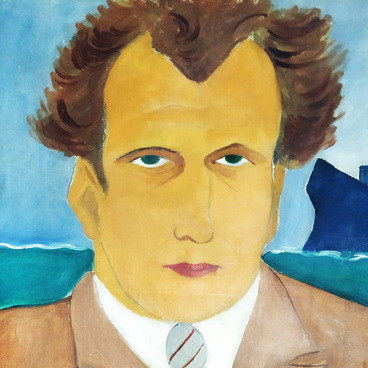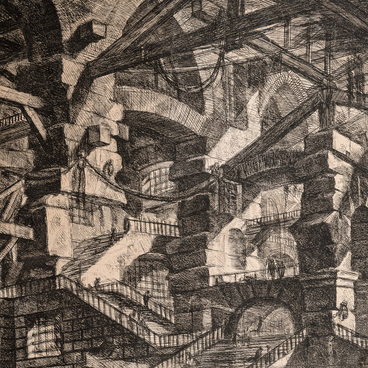This photograph depicts Antoine Louis Prosper Lemaître, who lived between 1800 and 1876, a Parisian actor and playwright who performed under the stage name of Frédérick Lemaître. He democratized the French theater, suffused the art of reciting with a vivid folksy touch, and mocked the old-fashioned dancing style of the French court theater.
Lemaître was one of the most famous actors in the Parisian boulevard theater scene. Comedy, as well as other genres of boulevard performances—melodramas and detective stories—that brought fame to Frederick Lemaitre, later transferred to the cinematography realm. In his classical study, Pathos, Eisenstein devoted a chapter entitled ‘The Aging Lion’ to Frédérick Lemaître’s personality and acting style, where he wrote: “Could there be anything more magnificent for his time than the ardor of this melodrama king, this passionate lion and the unchallenged master of the Parisian stage…” The director saw the secret to this ardor in the skill to blend polar traits of personality into a role and use the temperament to reach out to the viewer.
In July 1823, Frédérick Lemaître first played the fugitive villain Robert Macaire in the drama L’Auberge des Adrets based on the play by Benjamin Antier, Saint-Amand and Polyanthe. The authors were astonished by the way he turned a drama into a satirical comedy. Robert Macaire played by Frédérick Lemaître—charming and impudent, brave and cynical, witty and predatory—challenged the police: he turned into the chairman of a joint-stock company and shamelessly robbed shareholders. The character created by Lemaître was so representative of the emergent years of French capitalism that it inspired a series of satirical engravings by French graphic artist Honoré Daumier, while the coinage ‘Macairism’ became a legitimate term. After 85 performances, the play was censored. In 1840, Lemaître starred in Balzac’s play Vautrin, where he made himself up as adventurer Eugène-François Vidoc (the prototype of his character). The make-up also resembled King Louis-Philippe, so the play was banned by the Minister of the Interior shortly after the premiere.
This photo of the actor was shot in the 1860s by Etienne Carjat (1828–1906), a poet and photographer who later became a mouthpiece for the Paris Commune. This portrait of Frédérick Lemaître was highly appreciated by the great master of 19th-century photography, Nadar, who described the photo as being “as delicate as Holbein and as fluent as van Dyck.” Eisenstein had an authentic copy of the photomechanical print of the portrait hung on the rack in his library.
The names of Frédérick Lemaître and his contemporary Charles Deburau, who revolutionized the pantomime, were enshrined in Marcel Carne’s movie Children of Paradise (1945).
Lemaître was one of the most famous actors in the Parisian boulevard theater scene. Comedy, as well as other genres of boulevard performances—melodramas and detective stories—that brought fame to Frederick Lemaitre, later transferred to the cinematography realm. In his classical study, Pathos, Eisenstein devoted a chapter entitled ‘The Aging Lion’ to Frédérick Lemaître’s personality and acting style, where he wrote: “Could there be anything more magnificent for his time than the ardor of this melodrama king, this passionate lion and the unchallenged master of the Parisian stage…” The director saw the secret to this ardor in the skill to blend polar traits of personality into a role and use the temperament to reach out to the viewer.
In July 1823, Frédérick Lemaître first played the fugitive villain Robert Macaire in the drama L’Auberge des Adrets based on the play by Benjamin Antier, Saint-Amand and Polyanthe. The authors were astonished by the way he turned a drama into a satirical comedy. Robert Macaire played by Frédérick Lemaître—charming and impudent, brave and cynical, witty and predatory—challenged the police: he turned into the chairman of a joint-stock company and shamelessly robbed shareholders. The character created by Lemaître was so representative of the emergent years of French capitalism that it inspired a series of satirical engravings by French graphic artist Honoré Daumier, while the coinage ‘Macairism’ became a legitimate term. After 85 performances, the play was censored. In 1840, Lemaître starred in Balzac’s play Vautrin, where he made himself up as adventurer Eugène-François Vidoc (the prototype of his character). The make-up also resembled King Louis-Philippe, so the play was banned by the Minister of the Interior shortly after the premiere.
This photo of the actor was shot in the 1860s by Etienne Carjat (1828–1906), a poet and photographer who later became a mouthpiece for the Paris Commune. This portrait of Frédérick Lemaître was highly appreciated by the great master of 19th-century photography, Nadar, who described the photo as being “as delicate as Holbein and as fluent as van Dyck.” Eisenstein had an authentic copy of the photomechanical print of the portrait hung on the rack in his library.
The names of Frédérick Lemaître and his contemporary Charles Deburau, who revolutionized the pantomime, were enshrined in Marcel Carne’s movie Children of Paradise (1945).



